Nothing. I bought nothing.
Well, more truthfully, I bought nothing that needs to be counted. I did buy some black and white T'boli beads during my trip to the Philippines. But according to comments on previous posts by my readers these need not be counted because:
(a) they're a souvenir
(b) they're handcrafts
(c) they're jewellery
So, the total for 2011 remains at 10.
Wednesday, August 31, 2011
Thankfully, socks.
Thankfully, I've finished Nancy Bush's Fox Faces,the fourth installment of the super special six pattern sock club (s62011) socks, by the nominal due date. I'm ignoring the fact for the moment that if I'm really going to complete this sock club I need to knit a pair of socks to substitute for the third installment - the Leyburn pattern I wimped out on.

This is such an interesting pattern. It's almost as if Nancy Bush had designed them as a sampler to demonstrate a range of ideas you can include in a pair of socks. As well as the rather cute fox faces lace pattern itself, there's the lateral braid on the sock cuff; the honeycomb stitch for the heel; the dutch heel (love the dutch heel); and the unusual three sectioned star finish for the toe.
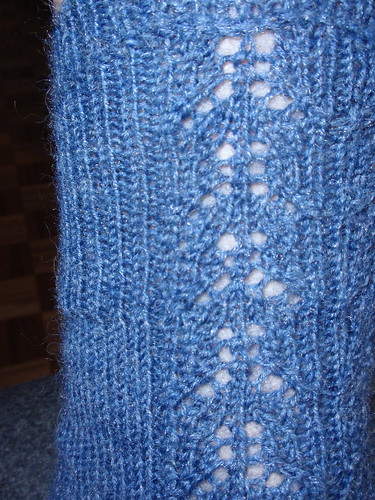
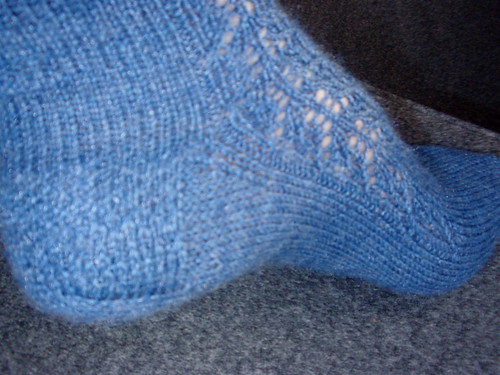
Any problems with these socks have been of my own making. This yarn - 4 ply sock yarn by Angel Yarns UK - has a slight halo and almost felted effect. It would make a wonderful traditional pair of plain or ribbed socks. But it's not ideal for this pattern, which would have been better with a tightly spun yarn with crisp stitch definition. Also, the socks are very snug on me. A sock pattern of 60 stitches on 2.25mm needles is never going to result in a generously (or even moderately) sized sock. But I have a neighbour with small feet who I'm sure would love some hand-knitted socks for next winter.

I like this pattern so much I intend to knit it again in a more suitable yarn.

This is such an interesting pattern. It's almost as if Nancy Bush had designed them as a sampler to demonstrate a range of ideas you can include in a pair of socks. As well as the rather cute fox faces lace pattern itself, there's the lateral braid on the sock cuff; the honeycomb stitch for the heel; the dutch heel (love the dutch heel); and the unusual three sectioned star finish for the toe.


Any problems with these socks have been of my own making. This yarn - 4 ply sock yarn by Angel Yarns UK - has a slight halo and almost felted effect. It would make a wonderful traditional pair of plain or ribbed socks. But it's not ideal for this pattern, which would have been better with a tightly spun yarn with crisp stitch definition. Also, the socks are very snug on me. A sock pattern of 60 stitches on 2.25mm needles is never going to result in a generously (or even moderately) sized sock. But I have a neighbour with small feet who I'm sure would love some hand-knitted socks for next winter.

I like this pattern so much I intend to knit it again in a more suitable yarn.
Monday, August 29, 2011
The fabric of the past
I've been interested in traditional, usually handmade textiles for many years - particularly those from Southeast Asia. I've never been able to afford to buy very valuable textiles, but over the years some of the bits of cloth in my collection - a grand word for the piles of fabric around my house - have become rare or are no longer available. It's sad to see such beautiful creations disappearing, but making hand-woven or richly embroidered textiles, except for the grandest occasions, is just no longer financially viable. Raw materials are expensive, markets need to be regularly supplied, and even low-paying jobs often generate more income for a family than handcrafts.
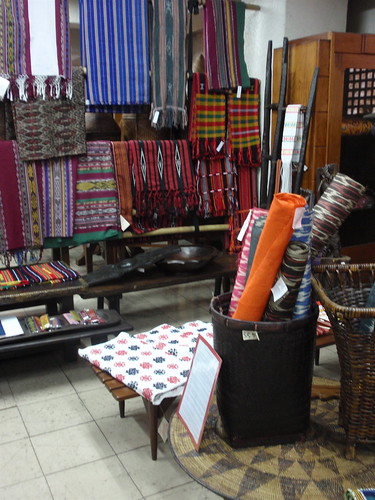
So I always have some trepidation when I visit Silahis, a wonderful multi-storey treasure store of Philippine crafts. There are always lots of baskets and wood carvings for sale but, over the last years, the variety and quantity of the available textiles are dwindling. I was delighted this visit to find some modern reproductions of Gaddang textiles, made by the Gaddang people of northeastern Luzon. I'd seen beautiful old expensive Gaddang textiles but hadn't ever bought any; these reproductions, handwoven and traditionally decorated with tiny white beads are lovely and very affordable.
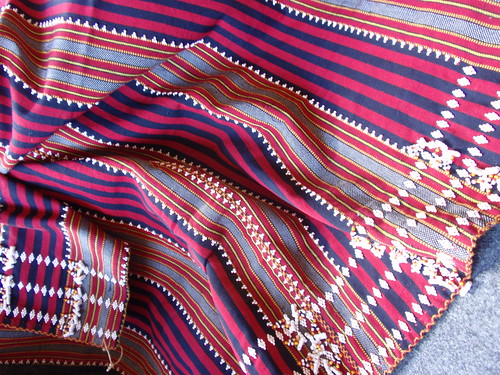

The shop also had some reproductions of Kalinga textiles from the mountains of northern Luzon, and I was unable to resist some tiny black and white T'boli beads from central Mindanao - the southernmost island of the Philippines.
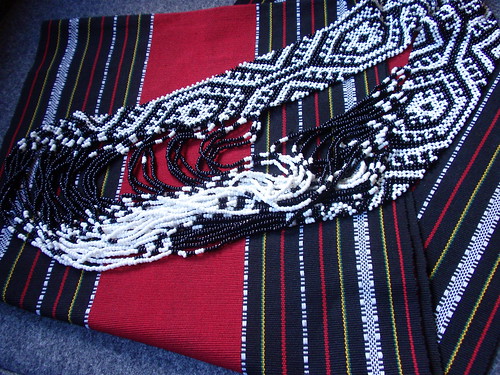
And finally, some embroidered handkerchiefs made from (imitation) pina cloth - the cloth traditionally used for men's formal shirts, the barong tagalog, and the beautiful shoulder-framing shawl-like collars of Spanish-influenced traditional dress for women.
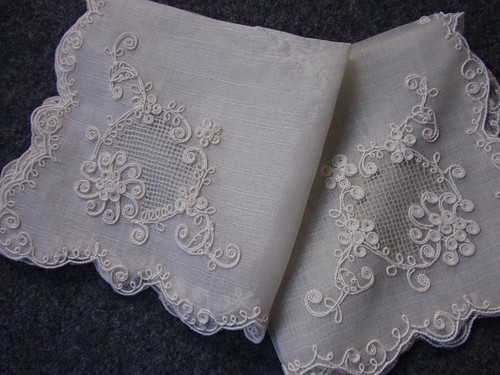
Pina is very fine fabric woven from fibres extracted from the leaves of the pineapple plant. In the 1970s I actually saw women handweaving pina fabrics and marvelled at the patience required to knot the short fibres into a warp and then weave the translucent cloth. Nowadays pina cloth is more likely to be made from a mixture of fibres or from synthetics as I think my handkerchiefs are. But I love the fine embroidery and I like them as a memento of the past.

So I always have some trepidation when I visit Silahis, a wonderful multi-storey treasure store of Philippine crafts. There are always lots of baskets and wood carvings for sale but, over the last years, the variety and quantity of the available textiles are dwindling. I was delighted this visit to find some modern reproductions of Gaddang textiles, made by the Gaddang people of northeastern Luzon. I'd seen beautiful old expensive Gaddang textiles but hadn't ever bought any; these reproductions, handwoven and traditionally decorated with tiny white beads are lovely and very affordable.


The shop also had some reproductions of Kalinga textiles from the mountains of northern Luzon, and I was unable to resist some tiny black and white T'boli beads from central Mindanao - the southernmost island of the Philippines.

And finally, some embroidered handkerchiefs made from (imitation) pina cloth - the cloth traditionally used for men's formal shirts, the barong tagalog, and the beautiful shoulder-framing shawl-like collars of Spanish-influenced traditional dress for women.

Pina is very fine fabric woven from fibres extracted from the leaves of the pineapple plant. In the 1970s I actually saw women handweaving pina fabrics and marvelled at the patience required to knot the short fibres into a warp and then weave the translucent cloth. Nowadays pina cloth is more likely to be made from a mixture of fibres or from synthetics as I think my handkerchiefs are. But I love the fine embroidery and I like them as a memento of the past.
Thursday, August 25, 2011
Nine days in the Philippines
I've been travelling again. Though I've only recently returned from my Malaysian trip, this time I had a very special reason for travelling. Three months ago, my son, who's living in the Philippines, and his partner had a baby boy - Joshua John. The baby was born two months prematurely and he initially had quite a tough time with lots of setbacks. I really felt I had to visit so I could get to know Joshua at this stage of his life. Fortunately, over the last few weeks he's really flourished and is now a picture of health and contentment.
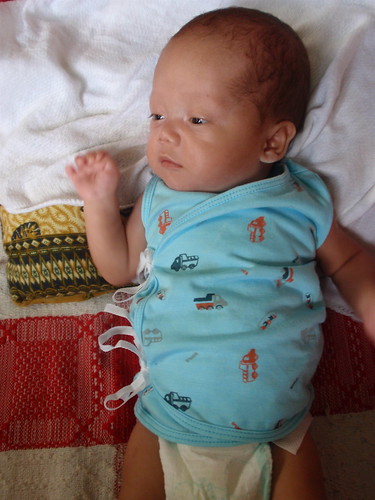
So I spent most of my week or so in the Philippines just admiring Joshua. But I did manage a few other activities:
* I visited Intramuros - the oldest part of Manila and once a walled city where we saw a wedding with very grandly dressed guests in the late sixteenth century church of San Agustin;

where we were ushered across the street by a guard dressed in an 'historic' Katipunan uniform to my favourite craft and textile shop (but more of that in another post);

and where we strolled through the ruins of Fort Santiago and remembered Filipino hero Jose Rizal whose one hundred and fiftieth anniversary year this is.

I'm not sure how useful Rizal's advice now is. The Philippines' complex and often unfortunate history is certainly useful in understanding the present state of Philippine society and politics, but history doesn't provide any easy answers for how to exist in modern Asia. [Just as an aside - one of the unexpected minor pleasures of visiting Manila is the newspapers. Clearly I'm limited to English-language newspapers, but the Philippine press must be amongst the most free in the world. Most of the news stories are so partisan or so local or so convoluted I can't really appreciate them, but I love the comment columns...everything from sophisticated and informed sociological commentary on a current debate about art and blasphemy through to impassioned pleas from overseas Filipino workers arguing they should not be compulsorily expatriated from Libya because their families need the income they're generating. A window to a very different world].
* I had a two day trip to Magdalena, about 150k south of Manila in the province of Laguna where I stayed in a bahay kubo - a house of traditional materials. The house has grown somewhat since we spent Christmas there a couple of years ago so this time there was a separate living room where Joshua and I spent most of our time
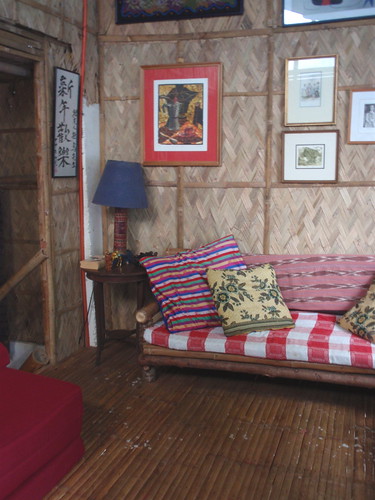
and a brand new bedroom where I, (probably because I'm fussiest) had the honour of sleeping

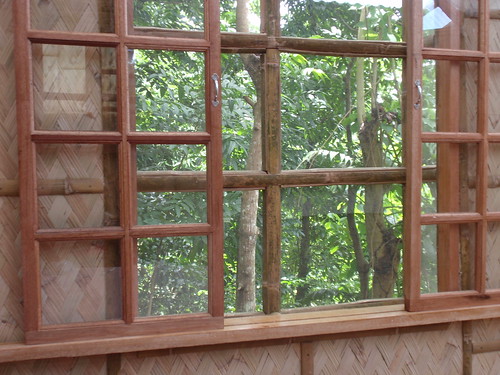
There's lots to like and admire about a bahay kubo. It literally sits very lightly upon the ground. Almost all the materials are either locally gathered (the bamboo for the walls and floors; many of the support posts) or locally crafted (the lovely window frames). Reluctantly, after the thatched roof had been twice destroyed by typhoons, the roof has been replaced with a kind of hardy corrugated plastic. I particularly love the textures the local materials provide and the softness of the bamboo flooring that gives slightly beneath your weight. I love showering and having the water run through the bamboo slats to the luxurious undergrowth beneath the house. But I don't like the insects! My visit coincided with the season when termites grow wings and go hunting for new nests. Any attempt to read at night was thwarted by the surprisingly large winged termites attracted by the light. And there are ants and tiny bamboo inhabiting insects and...other things I could (and did) only imagine.
The area of Laguna in which Magdalena is situated is steeped in Philippine history. The large lake, the Laguna, that's the centre of the province, was a major transportation hub for the Spaniards who colonised the Philippines from the sixteenth to nineteenth centuries. It's partly the setting for Rizal's novels of nationalist sentiment that every Filipino school child has to study, Noli Mi Tangere and El Filibusterismo, and a major site for resistance to the Spanish in the late nineteenth century. The area is also just beautiful - but vulnerable. Overpopulation, over-fishing, periodic floods, pollution from fertiliser and pesticides, and growths of water hyacinth haven't quite destroyed the laguna (lake), but its health is precarious.
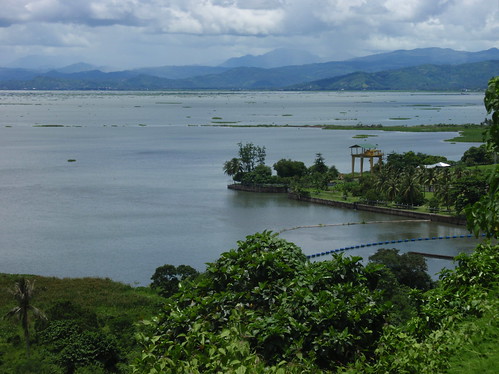
On the drive down to Magdalena we made a short detour via the town of Pila where luck or circumstance has enabled the preservation of a largish number of old houses around a charming town plaza.
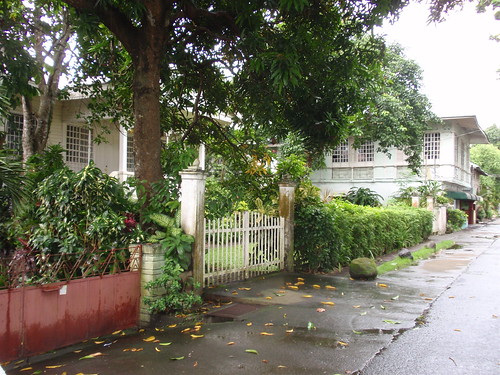
Some claim they're houses from the Spanish period, but I suspect a number of them date from the early twentieth century when the Philippines was a US colony. Anyway, the town has charm and I'd like to visit again - preferably when it's not raining.
* I did some malling (as in spending time in shopping malls). I malled in our local, crowded, cheap and cheerful mall
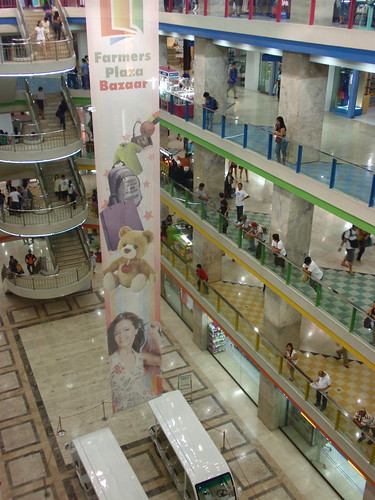
and I malled in the most beautiful, echoingly empty malls where every exclusive and expensive international design company is represented. I can't imagine how such places stay open. I certainly couldn't afford to shop in them and I've rarely seen others shopping in them. But they do have beautiful settings and meticulously cared for gardens.
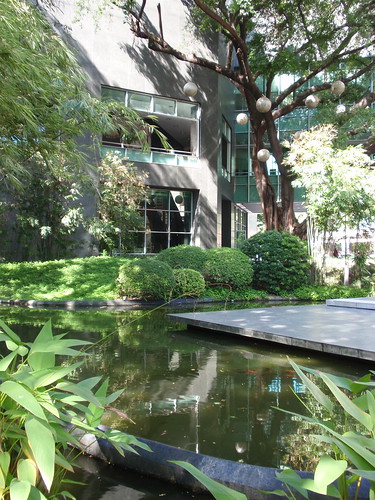
By the way, all I bought, (apart from traditional crafts), was baby clothes and baby paraphernalia, so there are no additions to my clothes tally for the year.
* Otherwise, I just hung around the house with Joshua, with brief forays into the local neighbourhood.
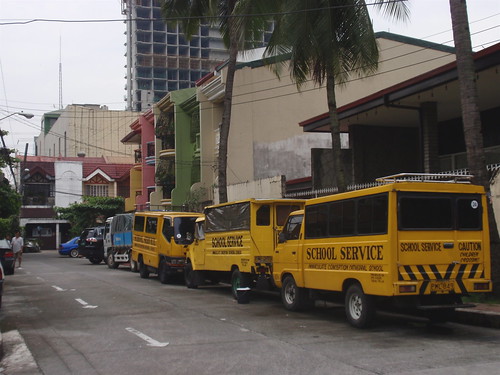
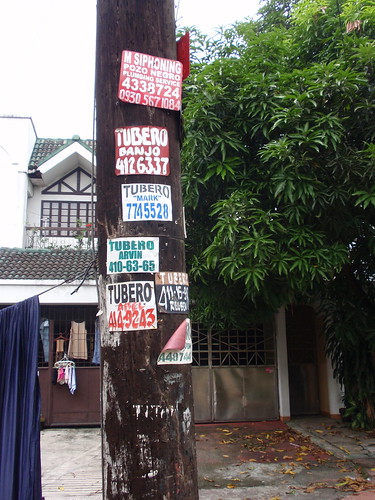
* And, as always happens when you visit Manila, I spent lots of time in traffic jams.

This is Aurora Boulevard, just around the corner from where I was staying. Eight lanes of traffic (in a road meant for six) with queues of jeepneys transporting people around the city, as well as two tracks for the ever-crowded light rail overhead. I guess transportation is always going to be a problem in a city of around 15 million people.
I'm not sure when I'll be back for another visit, but with Joshua's arrival I guess it won't be too long.

So I spent most of my week or so in the Philippines just admiring Joshua. But I did manage a few other activities:
* I visited Intramuros - the oldest part of Manila and once a walled city where we saw a wedding with very grandly dressed guests in the late sixteenth century church of San Agustin;

where we were ushered across the street by a guard dressed in an 'historic' Katipunan uniform to my favourite craft and textile shop (but more of that in another post);

and where we strolled through the ruins of Fort Santiago and remembered Filipino hero Jose Rizal whose one hundred and fiftieth anniversary year this is.

I'm not sure how useful Rizal's advice now is. The Philippines' complex and often unfortunate history is certainly useful in understanding the present state of Philippine society and politics, but history doesn't provide any easy answers for how to exist in modern Asia. [Just as an aside - one of the unexpected minor pleasures of visiting Manila is the newspapers. Clearly I'm limited to English-language newspapers, but the Philippine press must be amongst the most free in the world. Most of the news stories are so partisan or so local or so convoluted I can't really appreciate them, but I love the comment columns...everything from sophisticated and informed sociological commentary on a current debate about art and blasphemy through to impassioned pleas from overseas Filipino workers arguing they should not be compulsorily expatriated from Libya because their families need the income they're generating. A window to a very different world].
* I had a two day trip to Magdalena, about 150k south of Manila in the province of Laguna where I stayed in a bahay kubo - a house of traditional materials. The house has grown somewhat since we spent Christmas there a couple of years ago so this time there was a separate living room where Joshua and I spent most of our time

and a brand new bedroom where I, (probably because I'm fussiest) had the honour of sleeping


There's lots to like and admire about a bahay kubo. It literally sits very lightly upon the ground. Almost all the materials are either locally gathered (the bamboo for the walls and floors; many of the support posts) or locally crafted (the lovely window frames). Reluctantly, after the thatched roof had been twice destroyed by typhoons, the roof has been replaced with a kind of hardy corrugated plastic. I particularly love the textures the local materials provide and the softness of the bamboo flooring that gives slightly beneath your weight. I love showering and having the water run through the bamboo slats to the luxurious undergrowth beneath the house. But I don't like the insects! My visit coincided with the season when termites grow wings and go hunting for new nests. Any attempt to read at night was thwarted by the surprisingly large winged termites attracted by the light. And there are ants and tiny bamboo inhabiting insects and...other things I could (and did) only imagine.
The area of Laguna in which Magdalena is situated is steeped in Philippine history. The large lake, the Laguna, that's the centre of the province, was a major transportation hub for the Spaniards who colonised the Philippines from the sixteenth to nineteenth centuries. It's partly the setting for Rizal's novels of nationalist sentiment that every Filipino school child has to study, Noli Mi Tangere and El Filibusterismo, and a major site for resistance to the Spanish in the late nineteenth century. The area is also just beautiful - but vulnerable. Overpopulation, over-fishing, periodic floods, pollution from fertiliser and pesticides, and growths of water hyacinth haven't quite destroyed the laguna (lake), but its health is precarious.

On the drive down to Magdalena we made a short detour via the town of Pila where luck or circumstance has enabled the preservation of a largish number of old houses around a charming town plaza.

Some claim they're houses from the Spanish period, but I suspect a number of them date from the early twentieth century when the Philippines was a US colony. Anyway, the town has charm and I'd like to visit again - preferably when it's not raining.
* I did some malling (as in spending time in shopping malls). I malled in our local, crowded, cheap and cheerful mall

and I malled in the most beautiful, echoingly empty malls where every exclusive and expensive international design company is represented. I can't imagine how such places stay open. I certainly couldn't afford to shop in them and I've rarely seen others shopping in them. But they do have beautiful settings and meticulously cared for gardens.

By the way, all I bought, (apart from traditional crafts), was baby clothes and baby paraphernalia, so there are no additions to my clothes tally for the year.
* Otherwise, I just hung around the house with Joshua, with brief forays into the local neighbourhood.


* And, as always happens when you visit Manila, I spent lots of time in traffic jams.

This is Aurora Boulevard, just around the corner from where I was staying. Eight lanes of traffic (in a road meant for six) with queues of jeepneys transporting people around the city, as well as two tracks for the ever-crowded light rail overhead. I guess transportation is always going to be a problem in a city of around 15 million people.
I'm not sure when I'll be back for another visit, but with Joshua's arrival I guess it won't be too long.
Monday, August 22, 2011
Simple
A few weeks ago I took the brief walk from work to the station with a colleague I no longer see very often. It was in the midst of the un-Sydney-like cold spell we had a few weeks ago and she was saying how much she felt the cold. She was wearing a pair of fingerless gloves and extolling their virtue.
Coincidentally, I'd just finished my Zumthor hat using Brooklyn Tweed's Shelter yarn. I'd had to break into a second ball of yarn to finish the hat and had kept the unfinished skein on my coffee table. You know what it's like...if you put the partly used skein away 'safely', it disappears forever. I didn't want this to happen, but, wonderful though the yarn is, I also didn't really want a partly finished skein of yarn as a constant feature on my coffee table.
So, I decided to make my friend some more fingerless gloves. At least I knew she would wear and appreciate them. Two evenings later and even I, slow knitter that I am, had finished the mitts.

The pattern is Leslie Friend's much-knitted Toasty. The yarn is Brooklyn Tweed's Shelter in 'Nest' colourway. I used 5.00mm needles and the knitting was super-quick for a very satisfactory outcome.
And - best of all - my colleague seems to like them.
Coincidentally, I'd just finished my Zumthor hat using Brooklyn Tweed's Shelter yarn. I'd had to break into a second ball of yarn to finish the hat and had kept the unfinished skein on my coffee table. You know what it's like...if you put the partly used skein away 'safely', it disappears forever. I didn't want this to happen, but, wonderful though the yarn is, I also didn't really want a partly finished skein of yarn as a constant feature on my coffee table.
So, I decided to make my friend some more fingerless gloves. At least I knew she would wear and appreciate them. Two evenings later and even I, slow knitter that I am, had finished the mitts.

The pattern is Leslie Friend's much-knitted Toasty. The yarn is Brooklyn Tweed's Shelter in 'Nest' colourway. I used 5.00mm needles and the knitting was super-quick for a very satisfactory outcome.
And - best of all - my colleague seems to like them.
Thursday, August 11, 2011
Just right
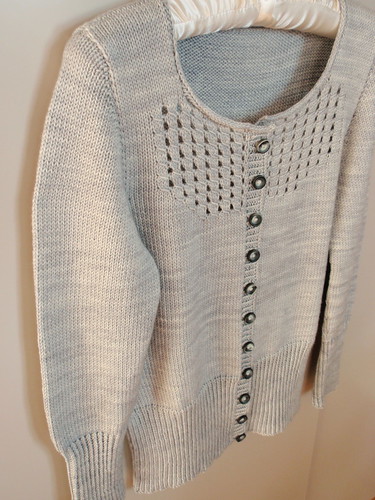
I'm very very happy with my latest completed knitting project. I don't often attempt what I think of as 'large' garments - jumpers or cardigans or (heaven forbid) dresses. I'm rather a slow knitter and, for myself, have a preference for quite plain knitted garments - which are then boring to knit. But the popular Audrey in Unst pattern, by Scottish designer Gudrun Johnson, really appealed to me. It's an ideal balance of plain elements - the stocking stitch body and sleeves - with decorative details - the deep twisted rib basque and cuffs and the seemingly smocked front yoke.
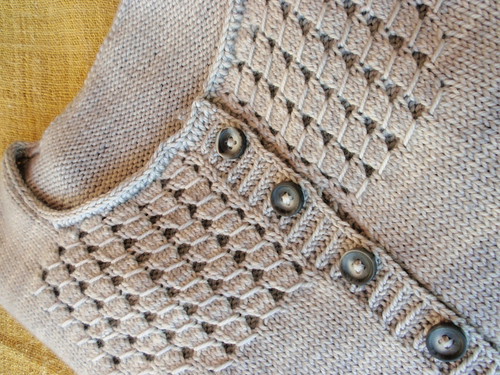
Once you start knitting, there are additional pleasures. The pattern is beautifully and clearly written with just the right amount of information, and the cardigan has been designed with such neat finishes - the ribbing, the perfect set-in sleeves, and the i-cord edging at the neck.
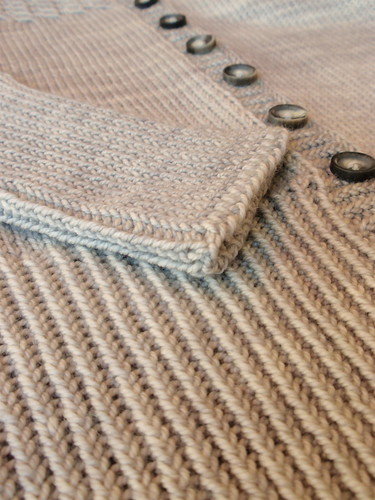
I had only four skeins of the Madelinetosh Sport weight yarn - not enough for a cardigan for me, but just right for my daughter. The yarn is just as pleasing as the pattern and for similar reasons of balance. The gradations of colour in the yarn, appropriately named 'silver fox', bring variety, but its neat twist and clear stitch definition give regularity.
I'd bought some beautiful old glass buttons that were a perfect match for this colour, but had to abandon them as I didn't have enough of them. I then bought shell buttons, which were also a perfect match, but they were too large. Eventually I bought the buttons I've used from the ever-reliable All Buttons Great and Small in Newtown - just the right size, just right mottled grey colour, and the right number. And I still have some beautiful buttons to be used for later projects.
I put the cardigan in the post to my daughter yesterday. Now all I have to hope for is that it fits.
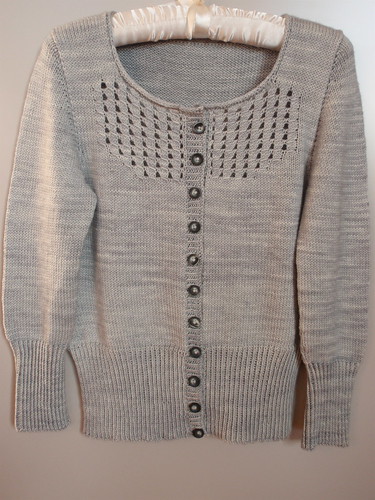
Wednesday, August 10, 2011
Crime fiction echoing life
I'm not quite sure how or why it happened, but at some stage my blog became my public conscience on a number of matters. There's my public accounting for clothes buying in 2011, and public disclosure of my successes and failures with my sock knitting. And then a few months ago, overwhelmed by shame at my reading habits, I made the resolution to read ten non-crime fiction books before I allowed myself to return to crime fiction. And then promptly forgot about my challenge to myself.
But I must have internalised the intention because, of the next eleven books I read, ten were not crime fiction. A victory of some sort.
However, sometimes reading crime fiction is very rewarding (and very often it's distracting and enjoyable). I've just had a rather freaky reading experience.
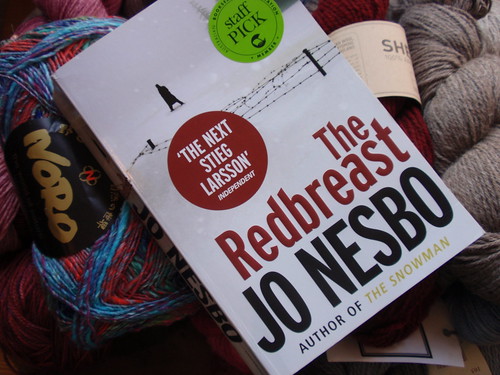
Rather belatedly, I've been reading Jo Nesbo's 'The Redbreast' - originally written in Norwegian in 2000 and then translated into English in 2006. [The cover of my edition of the book promotes Nesbo as 'the next Stieg Larsson', which must be rather galling for Nesbo as he was writing to great acclaim well before Steig Larsson published the 'Millenium' trilogy.] A key focus of Nesbo's novel is the story of a group of young Norwegian men who supported Hitler's view of the world and chose to fight with German troops on the Eastern front during the second world war. Also part of the story is modern neo-Nazism, influenced by the stories of these men, and its resentment of modern Norway's values. Nesbo implies that there is a long minority history of pro-Nazi views and affiliations hidden behind Norway's current peace-seeking stance. I was reading this book just as the horrific recent killings occurred in Norway. There was an uncanny parallel between the speeches and views of the some of the characters in Nesbo's novel and those of Anders Behring Breivik. Given it was written in 2000, 'The Redbreast' seemed very prescient.
Sometimes it's easy to justify my reading habits.
But I must have internalised the intention because, of the next eleven books I read, ten were not crime fiction. A victory of some sort.
However, sometimes reading crime fiction is very rewarding (and very often it's distracting and enjoyable). I've just had a rather freaky reading experience.

Rather belatedly, I've been reading Jo Nesbo's 'The Redbreast' - originally written in Norwegian in 2000 and then translated into English in 2006. [The cover of my edition of the book promotes Nesbo as 'the next Stieg Larsson', which must be rather galling for Nesbo as he was writing to great acclaim well before Steig Larsson published the 'Millenium' trilogy.] A key focus of Nesbo's novel is the story of a group of young Norwegian men who supported Hitler's view of the world and chose to fight with German troops on the Eastern front during the second world war. Also part of the story is modern neo-Nazism, influenced by the stories of these men, and its resentment of modern Norway's values. Nesbo implies that there is a long minority history of pro-Nazi views and affiliations hidden behind Norway's current peace-seeking stance. I was reading this book just as the horrific recent killings occurred in Norway. There was an uncanny parallel between the speeches and views of the some of the characters in Nesbo's novel and those of Anders Behring Breivik. Given it was written in 2000, 'The Redbreast' seemed very prescient.
Sometimes it's easy to justify my reading habits.
Friday, August 5, 2011
A golden anniversary
Several weeks ago I received a most unexpected invitation. I was asked to give an address for Education Week at my old high school. In case you are thinking this is a great and meritorious honour, I should give you some context for this invitation. I grew up in the small town of Grenfell (population around 2,000) in central-west NSW - about 370 km due west of Sydney.
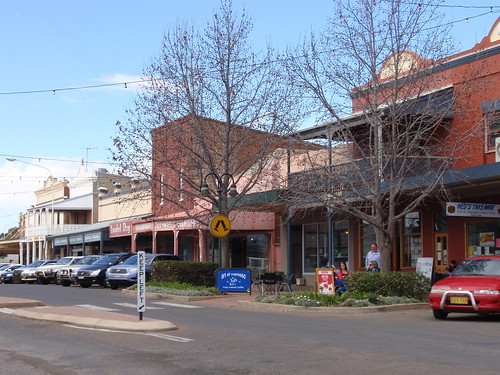
[Grenfell's Main Street]
It's fifty years since I finished high school and in my final year at the school it was formally reclassified by the Department of Education as a High School and took on the name The Henry Lawson High School (the renowned, pessimistic bush poet, short story writer and drunkard Henry Lawson was born about 100 metres from the school's present location). I was school captain during that year and so I guess someone deemed it appropriate to ask me back fifty years later.
I drove up to Grenfell one day and back to Sydney the following day - a real achievement for me as I really don't like driving. But despite the going and coming it was a wonderful visit. The high school has always been small - around 180 kids when I attended and nowadays around 240. My first real job was teaching in a country high school at Narrandera which was a bit bigger than Grenfell, but shared many of the same characteristics. I like the comprehensiveness of such schools. There are girls and boys, intelligent and not so intelligent, rich and poor, those skilled at sports and those (like me) who suffered through games and physical activities. You can't attend such a school and have any illusions about the diversity of people and their skills and opportunities. I also like the way such schools are embedded in their communities and serve as a focal point for many community groups and projects.
At the school assembly the school band played and the choir sang; awards were presented to community members who had assisted the school; the final of the school spelling bee was held with participants so nervous we were all sitting on the edges of our seats with tension; awards were presented to students; and I gave my speech. It was easy to find things to say about an experience that had played such a formative role in my life - and also that of other members of my family. Not only did I complete my schooling at this school in 1961, but my brother was school captain in 1966, my father attended there till he left school aged 15 in 1931, and his mother left the Grenfell Superior School (at age 13) in 1899. Such a rich line of connection.
I stayed overnight with a friend from my school days and her husband who live on a farm in a gracious 1910 traditional Australian homestead.

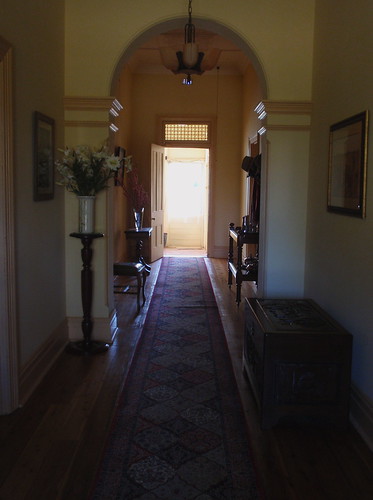
My friend is the third generation of her family to have lived in this house and it will pass on to her son and possibly other generations. Even though I seem to have broken with these lines of tradition by moving away from Grenfell I like to know that such continuity is possible.
The house has a wonderful big old garden where early spring flowers are just emerging. There are lots of nostalgically scented plants and my friend brings them inside in vases throughout the house. My bedroom was scented by some sprigs of daphne which evokes memories of my mother who always cultivated a daphne bush.
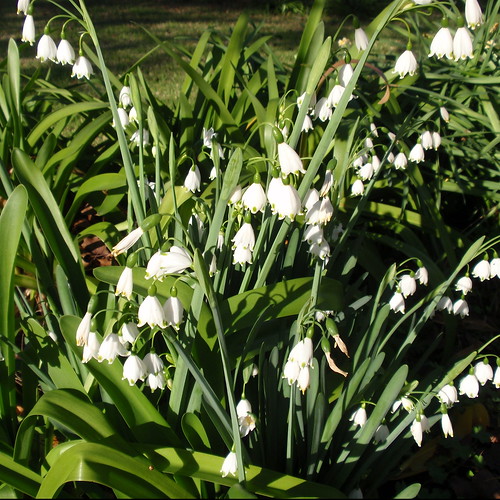
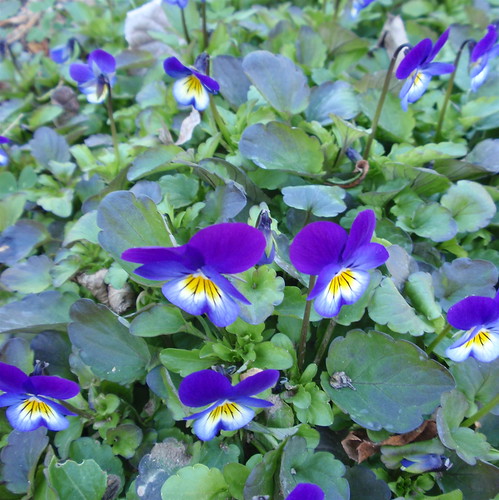
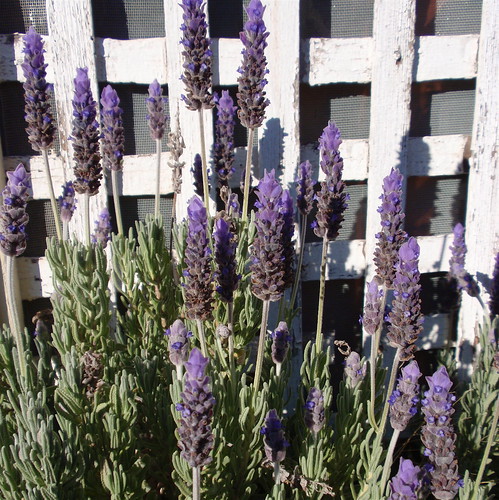

And there were the lambs. Because of all the rain last year and the rich pasture it produced, my friends have been overwhelmed this year by the very high lamb birth rates. Inevitably, a number of lambs have lost their mothers or the mothers have had difficulty feeding and so some of the lambs need to be bottle-fed.
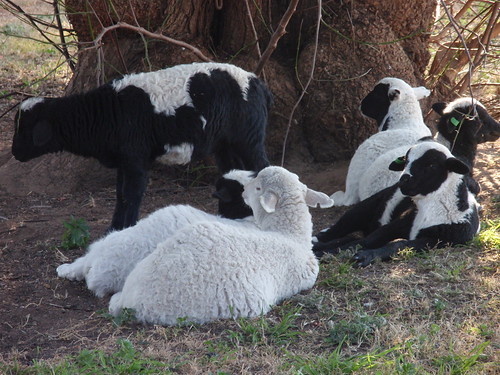
This handsome group are just about ready to graduate from milk to pasture and are looking very plump and healthy. This variety of sheep - called Dorper - are not wool sheep but rather are being bred to eat. Almost seems a shame when they're so cute, but for those of us meat-eaters, it's the cost of having our lamb cutlets and roasts.
Visiting Grenfell always reminds me of my family roots and upbringing. It's all so familiar and yet now so distant in my life. I inevitably made a bit of a pilgrimage to places that are integral to my memories of growing up and the family stories I was told...
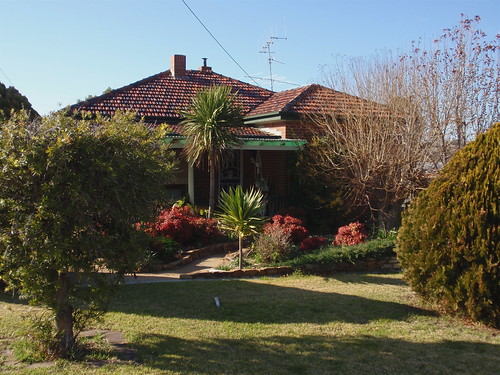
[The 1930s bungalow my parents lived in from 1948 onwards and where I lived until I left home for university. My dad's garden would have had fewer shrubs and at this time of the year the first spring annuals]

[The farmhouse outside Grenfell built by my grandfather sometime around 1920. This is where my mother grew up and my grandfather wrote his diaries]

[The cluster of trees near the farmhouse above where my great-grandfather built a slab hut sometime in the 1880s when he settled this land and brought his family to live here.]
And a final country story. I pulled to the side of the road on my way into Grenfell to take the two photographs above. I'd not been there more than three minutes before a farmer came out of a nearby house to check that I was OK. It's what I both love and fear about country towns - that you are generously cared for and helped, but that you have no anonymity whatsoever.

[Grenfell's Main Street]
It's fifty years since I finished high school and in my final year at the school it was formally reclassified by the Department of Education as a High School and took on the name The Henry Lawson High School (the renowned, pessimistic bush poet, short story writer and drunkard Henry Lawson was born about 100 metres from the school's present location). I was school captain during that year and so I guess someone deemed it appropriate to ask me back fifty years later.
I drove up to Grenfell one day and back to Sydney the following day - a real achievement for me as I really don't like driving. But despite the going and coming it was a wonderful visit. The high school has always been small - around 180 kids when I attended and nowadays around 240. My first real job was teaching in a country high school at Narrandera which was a bit bigger than Grenfell, but shared many of the same characteristics. I like the comprehensiveness of such schools. There are girls and boys, intelligent and not so intelligent, rich and poor, those skilled at sports and those (like me) who suffered through games and physical activities. You can't attend such a school and have any illusions about the diversity of people and their skills and opportunities. I also like the way such schools are embedded in their communities and serve as a focal point for many community groups and projects.
At the school assembly the school band played and the choir sang; awards were presented to community members who had assisted the school; the final of the school spelling bee was held with participants so nervous we were all sitting on the edges of our seats with tension; awards were presented to students; and I gave my speech. It was easy to find things to say about an experience that had played such a formative role in my life - and also that of other members of my family. Not only did I complete my schooling at this school in 1961, but my brother was school captain in 1966, my father attended there till he left school aged 15 in 1931, and his mother left the Grenfell Superior School (at age 13) in 1899. Such a rich line of connection.
I stayed overnight with a friend from my school days and her husband who live on a farm in a gracious 1910 traditional Australian homestead.


My friend is the third generation of her family to have lived in this house and it will pass on to her son and possibly other generations. Even though I seem to have broken with these lines of tradition by moving away from Grenfell I like to know that such continuity is possible.
The house has a wonderful big old garden where early spring flowers are just emerging. There are lots of nostalgically scented plants and my friend brings them inside in vases throughout the house. My bedroom was scented by some sprigs of daphne which evokes memories of my mother who always cultivated a daphne bush.




And there were the lambs. Because of all the rain last year and the rich pasture it produced, my friends have been overwhelmed this year by the very high lamb birth rates. Inevitably, a number of lambs have lost their mothers or the mothers have had difficulty feeding and so some of the lambs need to be bottle-fed.

This handsome group are just about ready to graduate from milk to pasture and are looking very plump and healthy. This variety of sheep - called Dorper - are not wool sheep but rather are being bred to eat. Almost seems a shame when they're so cute, but for those of us meat-eaters, it's the cost of having our lamb cutlets and roasts.
Visiting Grenfell always reminds me of my family roots and upbringing. It's all so familiar and yet now so distant in my life. I inevitably made a bit of a pilgrimage to places that are integral to my memories of growing up and the family stories I was told...

[The 1930s bungalow my parents lived in from 1948 onwards and where I lived until I left home for university. My dad's garden would have had fewer shrubs and at this time of the year the first spring annuals]

[The farmhouse outside Grenfell built by my grandfather sometime around 1920. This is where my mother grew up and my grandfather wrote his diaries]

[The cluster of trees near the farmhouse above where my great-grandfather built a slab hut sometime in the 1880s when he settled this land and brought his family to live here.]
And a final country story. I pulled to the side of the road on my way into Grenfell to take the two photographs above. I'd not been there more than three minutes before a farmer came out of a nearby house to check that I was OK. It's what I both love and fear about country towns - that you are generously cared for and helped, but that you have no anonymity whatsoever.
Subscribe to:
Posts (Atom)